2018 School Spending Survey Report
The Contenders | Guessing Geisel
The "Guessing Geisel" bloggers put forth their predictions for the titles they think have a strong shot at taking home a medal or honor at this year's YMAs.
The Contenders
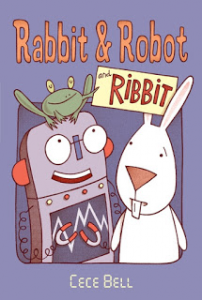 Rabbit & Robot and Ribbit by Cece Bell Full of fun wordplay and repetition, this hilarious book with an eye-catching cover focuses on the universal difficulty of sharing your bestie with a new friend. Rabbit makes a surprise visit to Robot, only to discover Robot’s new frog friend Ribbit is already there. The strong story and loveable characters are supported by the clear layout of text and illustrations and ample white space.
Rabbit & Robot and Ribbit by Cece Bell Full of fun wordplay and repetition, this hilarious book with an eye-catching cover focuses on the universal difficulty of sharing your bestie with a new friend. Rabbit makes a surprise visit to Robot, only to discover Robot’s new frog friend Ribbit is already there. The strong story and loveable characters are supported by the clear layout of text and illustrations and ample white space. 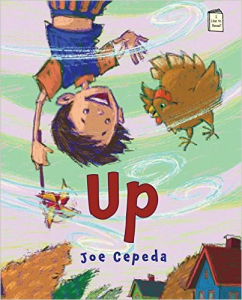 Up by Joe Cepeda A very windy day brings about a fabulous airborne adventure in this book for the newest of beginning readers. Sight words combine into simple sentences of no more than four words. The text pops against the white space, so cleverly designed into the swirling chaos of the digital illustrations. For such a simple story, the page-turning dynamic is impressive!
Up by Joe Cepeda A very windy day brings about a fabulous airborne adventure in this book for the newest of beginning readers. Sight words combine into simple sentences of no more than four words. The text pops against the white space, so cleverly designed into the swirling chaos of the digital illustrations. For such a simple story, the page-turning dynamic is impressive! 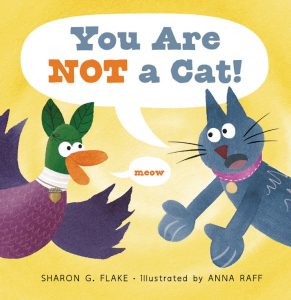 You Are NOT a Cat by Sharon G. Flake, illustrated by Anna Raff A silly duck drives an increasingly indignant cat wild by insisting it’s a cat. The duck admits it may not have the earmarks of a cat, but that doesn’t mean it can’t be a cat! The all-dialogue text is printed in a simple, legible font inside large speech bubbles. Soft colors and lightly textured backgrounds create plenty of white space. There are some definite parallels to Gerald and Piggie’s I Am A Frog adventure.
You Are NOT a Cat by Sharon G. Flake, illustrated by Anna Raff A silly duck drives an increasingly indignant cat wild by insisting it’s a cat. The duck admits it may not have the earmarks of a cat, but that doesn’t mean it can’t be a cat! The all-dialogue text is printed in a simple, legible font inside large speech bubbles. Soft colors and lightly textured backgrounds create plenty of white space. There are some definite parallels to Gerald and Piggie’s I Am A Frog adventure. 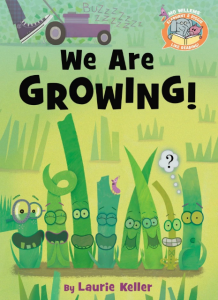 We Are Growing by Laurie Keller and Mo Willems In this melodramatic story, several shoots of grass (and one surprise dandelion) grow and ponder their existence and the things that make them special. Elephant and Piggie chime in with a few giggle-inducing introductory and closing remarks. Using Willems’ signature color-coded speech bubbles, short, declarative sentences, and strong, plot-driven word repetition, this new series is clearly intentionally designed for beginning readers.
We Are Growing by Laurie Keller and Mo Willems In this melodramatic story, several shoots of grass (and one surprise dandelion) grow and ponder their existence and the things that make them special. Elephant and Piggie chime in with a few giggle-inducing introductory and closing remarks. Using Willems’ signature color-coded speech bubbles, short, declarative sentences, and strong, plot-driven word repetition, this new series is clearly intentionally designed for beginning readers. 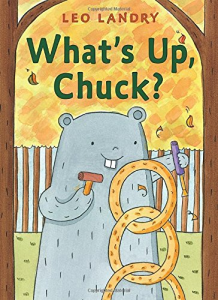 What’s Up, Chuck? by Leo Landry Chuck Wood is an artistically talented woodchuck, certain his wood carving will win the Best in the Forest art competition until Scooter Possum, a gifted abstract painter, arrives. Engaging from the get-go, Chuck and Scooter are a duo in the tradition of best friends Frog and Toad. The easy-to-read text features wonderful repetition and witty wordplay, including several knee-slapping knock-knock jokes. The pencil and watercolor illustrations provide insight into character relationships and break up the text into smaller, friendlier sections.
What’s Up, Chuck? by Leo Landry Chuck Wood is an artistically talented woodchuck, certain his wood carving will win the Best in the Forest art competition until Scooter Possum, a gifted abstract painter, arrives. Engaging from the get-go, Chuck and Scooter are a duo in the tradition of best friends Frog and Toad. The easy-to-read text features wonderful repetition and witty wordplay, including several knee-slapping knock-knock jokes. The pencil and watercolor illustrations provide insight into character relationships and break up the text into smaller, friendlier sections. 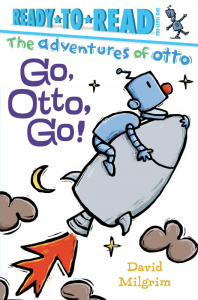 Go, Otto, Go! by David Milgrim Resourceful robot Otto builds a rocket so he can visit his family in outer space. Very short sentences made up of sight words, a very large font size, and colorful illustrations with clear visual context clues make this a strong contender. If the committee is looking at reading success for the very newest of new readers, then it seems likely this book will rocket to the top of the contender list.
Go, Otto, Go! by David Milgrim Resourceful robot Otto builds a rocket so he can visit his family in outer space. Very short sentences made up of sight words, a very large font size, and colorful illustrations with clear visual context clues make this a strong contender. If the committee is looking at reading success for the very newest of new readers, then it seems likely this book will rocket to the top of the contender list. 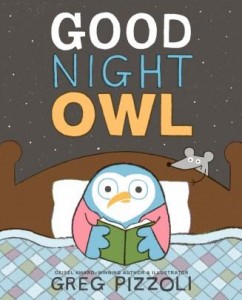 Good Night, Owl by Greg Pizzoli An irritable owl goes to great lengths to discover what is making the squeaking sound that is keeping him awake. After demolishing his entire house, he discovers the mouse that the reader has been aware of all along. The text is clear and legible, easy for beginning readers to follow. Pizzoli’s humorous illustrations provide plenty of support for the text, and the plot of the story will keep young readers engaged and turning pages until it reaches its conclusion.
Good Night, Owl by Greg Pizzoli An irritable owl goes to great lengths to discover what is making the squeaking sound that is keeping him awake. After demolishing his entire house, he discovers the mouse that the reader has been aware of all along. The text is clear and legible, easy for beginning readers to follow. Pizzoli’s humorous illustrations provide plenty of support for the text, and the plot of the story will keep young readers engaged and turning pages until it reaches its conclusion. 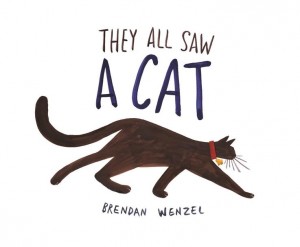 They All Saw a Cat by Brendan Wenzel We know what you’re thinking: that’s not a beginning reader! That’s what we thought too, but then a friend urged us to take a closer look (Thanks, Susan!). There are many strong elements in this picture book that explores the many perspectives of animals who all saw a cat. There’s rhythmic word repetition, clear design cues for new words, and fantastic illustrations with easy-to-pick-out visual context clues. This title definitely has the potential for a Geisel-Caldecott overlap!
They All Saw a Cat by Brendan Wenzel We know what you’re thinking: that’s not a beginning reader! That’s what we thought too, but then a friend urged us to take a closer look (Thanks, Susan!). There are many strong elements in this picture book that explores the many perspectives of animals who all saw a cat. There’s rhythmic word repetition, clear design cues for new words, and fantastic illustrations with easy-to-pick-out visual context clues. This title definitely has the potential for a Geisel-Caldecott overlap! 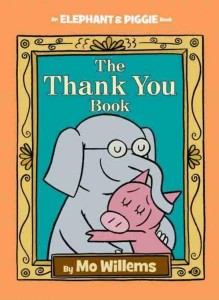 The Thank You Book by Mo Willems In their final volume, Piggie is determined to thank everyone who has contributed to the success of the series, but Gerald is concerned that someone might be left out. Is it possible to remember to thank everyone? The challenge for the Geisel committee here is that they can only consider this book on its own merits, without taking into consideration the many Geisel wins that this plucky pair has garnered in the past. Still, with its deliberate text placement, bountiful white space, and page-turning dynamic, there are plenty of positive elements that make this book a contender in its own right.
The Thank You Book by Mo Willems In their final volume, Piggie is determined to thank everyone who has contributed to the success of the series, but Gerald is concerned that someone might be left out. Is it possible to remember to thank everyone? The challenge for the Geisel committee here is that they can only consider this book on its own merits, without taking into consideration the many Geisel wins that this plucky pair has garnered in the past. Still, with its deliberate text placement, bountiful white space, and page-turning dynamic, there are plenty of positive elements that make this book a contender in its own right. 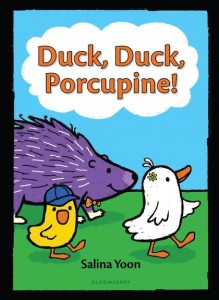 Duck, Duck, Porcupine by Selina Yoon With a starred review from SLJ and a plucky trio, Duck, Duck, Porcupine joins the list as boldly as the outlines on its digital illustrations. With three brief chapters—a formula that has had Geisel success recently with 2016 honor book A Pig, A Fox, and a Box—Yoon’s friendly story has just the right amount of humor and repeated vocabulary to spell success for a beginning reader.
Duck, Duck, Porcupine by Selina Yoon With a starred review from SLJ and a plucky trio, Duck, Duck, Porcupine joins the list as boldly as the outlines on its digital illustrations. With three brief chapters—a formula that has had Geisel success recently with 2016 honor book A Pig, A Fox, and a Box—Yoon’s friendly story has just the right amount of humor and repeated vocabulary to spell success for a beginning reader. RELATED
RECOMMENDED
CAREERS
The job outlook in 2030: Librarians will be in demand
CAREERS
The job outlook in 2030: Librarians will be in demand
ALREADY A SUBSCRIBER? LOG IN
We are currently offering this content for free. Sign up now to activate your personal profile, where you can save articles for future viewing






Add Comment :-
Be the first reader to comment.
Comment Policy:
Comment should not be empty !!!